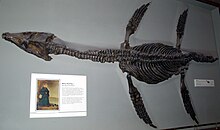
Back بليوصوريات Arabic بليوصوريات ARZ Pliosauroïdeus Catalan Pliosauroidea Danish Pliosaurier German Pliosauroidea Spanish بیشخزندهواران Persian Pliosaurukset Finnish Pliosauroidea French Pliosauroidea Irish
| Pliosauroids Temporal range:
| |
|---|---|

| |
| Cast of Rhomaleosaurus cramptoni (NHMUK PV R.34), Natural History Museum, London | |

| |
| Liopleurodon ferox mounted skeleton, Museum of Paleontology, Tübingen | |
| Scientific classification | |
| Domain: | Eukaryota |
| Kingdom: | Animalia |
| Phylum: | Chordata |
| Class: | Reptilia |
| Superorder: | †Sauropterygia |
| Order: | †Plesiosauria |
| Clade: | †Neoplesiosauria |
| Suborder: | †Pliosauroidea Welles, 1943 |
| Families and genera | |
|
see text | |
Pliosauroidea is an extinct clade of plesiosaurs, known from the earliest Jurassic to early Late Cretaceous. They are best known for the subclade Thalassophonea, which contained crocodile-like short-necked forms with large heads and massive toothed jaws, commonly known as pliosaurs. More primitive non-thalassophonean pliosauroids resembled plesiosaurs in possessing relatively long necks and smaller heads. They originally included only members of the family Pliosauridae, of the order Plesiosauria, but several other genera and families are now also included, the number and details of which vary according to the classification used.
The distinguishing characteristics are a short neck and an elongated head, with larger hind flippers compared to the fore flippers, the opposite of the plesiosaurs. They were carnivorous and their long and powerful jaws carried many sharp, conical teeth. Pliosaurs range from 4 to 10 meters or more in length.[1][2] Their prey may have included fish, sharks, ichthyosaurs, dinosaurs and other plesiosaurs.
The largest known species are Kronosaurus and Pliosaurus macromerus; other well known genera include Rhomaleosaurus, Peloneustes, and Macroplata.[3] Fossil specimens have been found in Africa, Australia, China, Europe, North America and South America.
Many very early (from the Early Jurassic and possibly Latest Triassic, i.e. Rhaetian) primitive pliosauroids were very like plesiosauroids in appearance and, indeed, used to be included in the family Plesiosauridae.
- ^ zoom dinosaurs
- ^ Sea reptile is biggest on record. BBC News, February 27, 2008.
- ^ Espen M. Knutsen; Patrick S. Druckenmiller; Jørn H. Hurum (2012). "A new species of Pliosaurus (Sauropterygia: Plesiosauria) from the Middle Volgian of central Spitsbergen, Norway". Norwegian Journal of Geology. 92 (2–3): 235–258. ISSN 0029-196X. Low resolusion pdf Archived 2012-12-02 at the Wayback Machine High resolusion pdf[dead link]